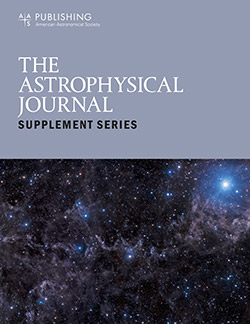COSMOS-DASH场H波段星系形态分类:基于组合的机器学习聚类模型
IF 8.5
1区 物理与天体物理
Q1 ASTRONOMY & ASTROPHYSICS
引用次数: 1
摘要
通过应用我们之前开发的两步星系形态分类方案,我们在COSMOS-DASH场中给出了H波段选择的大质量星系的星系形态目录,其中包括17,292个恒星质量为M的星系- >10 10 M⊙在0.5 <z & lt;2.5. 该分类方案旨在通过两个机器学习步骤的组合为星系提供完整的形态分类。我们首先使用一种无监督的机器学习方法(即基于bagging的多聚类)将星系分为五类:球形(SPH)、早型盘、晚型盘、不规则(IRR)和未分类。大约48%的星系(8258/ 17292)在这一阶段成功地聚集在一起。对于剩余的样本,我们采用有监督的机器学习方法(即GoogLeNet)对它们进行分类,在此过程中,我们将前一步分类好的星系作为我们的训练集。因此,我们获得了完整样本的形态学分类结果。t-SNE测试表明,我们样本中的星系可以很好地聚集。我们还测量了这些星系的参数和非参数形态。研究发现,ssamrsic指数从IRR到SPH增大,有效半径从IRR到SPH减小,符合相应的定义。不同类别的星系分别分布在G - m20空间中。这种与其他星系形态特征描述的一致性证明了我们分类结果的可靠性,确保了它可以作为进一步星系研究的基本目录。本文章由计算机程序翻译,如有差异,请以英文原文为准。
The Classification of Galaxy Morphology in the H Band of the COSMOS-DASH Field: A Combination-based Machine-learning Clustering Model
Abstract By applying our previously developed two-step scheme for galaxy morphology classification, we present a catalog of galaxy morphology for H -band-selected massive galaxies in the COSMOS-DASH field, which includes 17,292 galaxies with stellar mass M ⋆ > 10 10 M ⊙ at 0.5 < z < 2.5. The classification scheme is designed to provide a complete morphology classification for galaxies via a combination of two machine-learning steps. We first use an unsupervised machine-learning method (i.e., bagging-based multiclustering) to cluster galaxies into five categories: spherical (SPH), early-type disk, late-type disk, irregular (IRR), and unclassified. About 48% of the galaxies (8258/17,292) are successfully clustered during this step. For the remaining sample, we adopt a supervised machine-learning method (i.e., GoogLeNet) to classify them, during which galaxies that are well classified in the previous step are taken as our training set. Consequently, we obtain a morphology classification result for the full sample. The t-SNE test shows that galaxies in our sample can be well aggregated. We also measure the parametric and nonparametric morphologies of these galaxies. We find that the Sérsic index increases from IRR to SPH and the effective radius decreases from IRR to SPH, consistent with the corresponding definitions. Galaxies from different categories are separately distributed in the G – M 20 space. Such consistencies with other characteristic descriptions of galaxy morphology demonstrate the reliability of our classification result, ensuring that it can be used as a basic catalog for further galaxy studies.
求助全文
通过发布文献求助,成功后即可免费获取论文全文。
去求助
来源期刊

Astrophysical Journal Supplement Series
地学天文-天文与天体物理
CiteScore
14.50
自引率
5.70%
发文量
264
审稿时长
2 months
期刊介绍:
The Astrophysical Journal Supplement (ApJS) serves as an open-access journal that publishes significant articles featuring extensive data or calculations in the field of astrophysics. It also facilitates Special Issues, presenting thematically related papers simultaneously in a single volume.
 求助内容:
求助内容: 应助结果提醒方式:
应助结果提醒方式:


